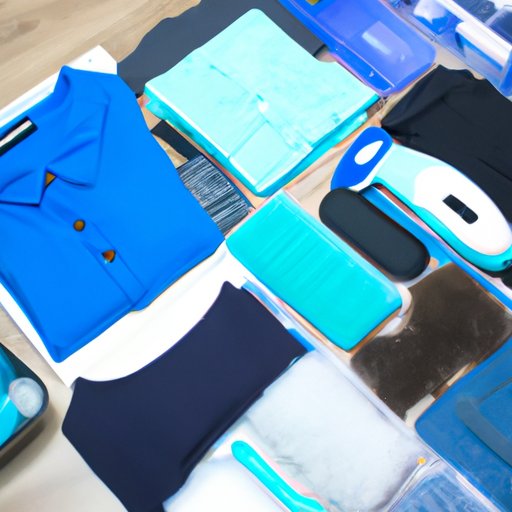Introduction
Traveling can be stressful, especially when it comes to packing. We all want to bring everything we need, but the limited luggage space can be a real challenge. Fortunately, there is a method to save space and pack more efficiently: Vacuum sealing clothes. This technique has become increasingly popular among travelers because it allows us to bring more clothes, protect them from dirt and spills, and avoid paying extra luggage fees. In this article, we will explore how this packing method works, its benefits, and how to do it right.
5 Reasons Why Vacuum Sealing Clothes Is a Game-changer for Travel
Vacuum sealing clothes has several advantages that make it a great option for travelers looking to make the most of their luggage space:
- Saves luggage space: By removing the air from the bag, you can reduce the volume of your clothes by up to 80%, leaving plenty of room for other items.
- Protects clothes from spills and dirt: Vacuum sealing bags are airtight and waterproof, preventing any liquids or dirt from getting inside and damaging your clothes.
- Prevents odor from spreading: When you vacuum seal your clothes, you also eliminate any odor that could spread throughout your suitcase, ensuring your clothes smell fresh and clean.
- Reduces the need for extra luggage: By compressing your clothes, you can bring more items in a single suitcase and avoid having to check-in additional bags.
- Saves money on luggage fees: Many airlines charge extra fees for checked luggage, but by reducing the amount of space your clothes take up, you can avoid these unnecessary costs.
How to Vacuum Seal Clothes for Space-saving and Organized Packing
If you want to vacuum seal your clothes, follow these simple steps:
- Choose the right vacuum-sealing bag: Look for bags made of durable and airtight materials, such as nylon or plastic. Also, make sure the bags are compatible with your vacuum cleaner.
- Place your clothes inside carefully: Fold your clothes neatly and place them inside the bag, avoiding any wrinkles or creases.
- Seal the bag according to instructions: Close the bag using the sealing strip provided, making sure it is tight and secure.
- Use a vacuum cleaner to remove all the air from the bag: Connect the vacuum cleaner to the valve on the bag and turn it on until all the air is removed, and the bag is completely compressed.
Once you’ve vacuum-sealed your clothes, you can organize them for maximum space-saving. Consider grouping items by category or outfit to make it easier to find what you need quickly.
Vacuum Sealing vs. Rolling: Which Packing Method Is Best for Travel?
Rolling clothes is another common space-saving packing method that many people prefer. However, there are some differences between vacuum sealing and rolling that may make one more suitable for your needs than the other.
Vacuum Sealing:
- Pros:
- More space-saving than rolling
- Better protection against spills and stains
- Odor-free
- Cons:
- Requires a vacuum cleaner and compatible bags
- Slightly more time-consuming
Rolling:
- Pros:
- Quick and easy
- You can roll almost any type of clothing
- Cons:
- Less space-saving than vacuum sealing
- No protection against spills and stains
- Wrinkles may form on some fabrics
Ultimately, the choice between vacuum sealing and rolling depends on your preferences, the length of your trip, and the type of clothes you need to pack.
The Benefits of Vacuum Sealing Clothes for Long-term Travel
Vacuum sealing clothes is not only suitable for short trips but can be a valuable technique for long-term travel. By using this method, you can pack enough clothes and avoid having to do laundry frequently, which is particularly useful when traveling to remote locations or areas without access to laundry facilities. Additionally, vacuum sealing helps protect your clothes from humidity and insects, which is crucial when traveling to tropical areas. If you’re planning to move frequently, vacuum-sealing your clothes can also make it easier to pack and unpack, as you don’t need to worry about fitting everything into limited storage space.
Tips from Frequent Travelers: How to Vacuum Seal Clothes for Stress-free Trips
If you’re new to vacuum sealing clothes or looking for ways to improve your technique, here are some tips from experienced travelers:
- Choose the right bag size: Make sure the bag is large enough to fit all your clothes comfortably, but not so big that it takes up unnecessary space.
- Be careful when sealing delicate fabrics: Delicate fabrics, such as silk or cashmere, can be damaged if the sealing strip is too tight. Place a tissue or a piece of cloth between the fabric and the sealing strip to prevent damage.
- Use a travel-sized vacuum cleaner: Many manufacturers offer compact vacuum cleaners that are more convenient to bring on a trip than a full-sized model.
- Consider using compression bags instead: Compression bags use a manual pump instead of a vacuum cleaner, which can be more flexible and easier to use when there’s no electricity available.
- Practice makes perfect: The more you vacuum seal your clothes, the more comfortable and efficient you’ll become. Don’t be discouraged if it takes a few tries to get it right!
Conclusion
Vacuum sealing clothes is a game-changer for travel, allowing you to save space, protect your clothes, and avoid unnecessary fees. By following the step-by-step instructions and tips provided in this article, you can vacuum seal your clothes like a pro and make your next trip stress-free. Whether you’re traveling for a few days or a few months, this packing method can help you enjoy your trip to the fullest.
(Note: Is this article not meeting your expectations? Do you have knowledge or insights to share? Unlock new opportunities and expand your reach by joining our authors team. Click Registration to join us and share your expertise with our readers.)
